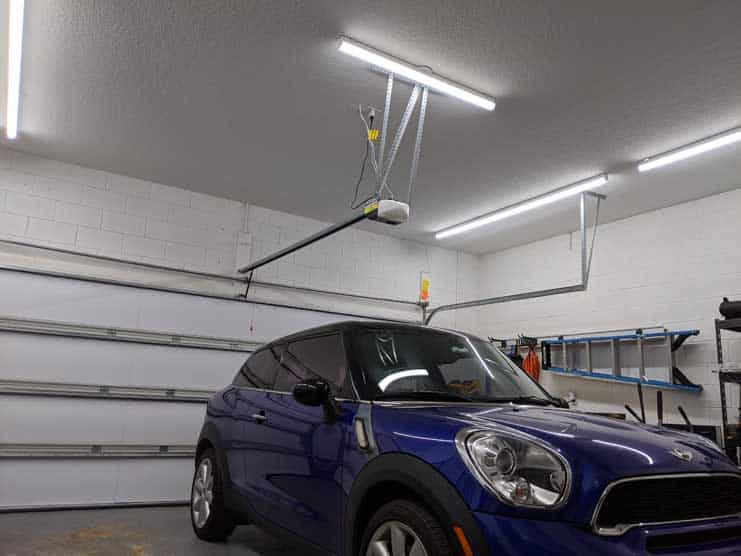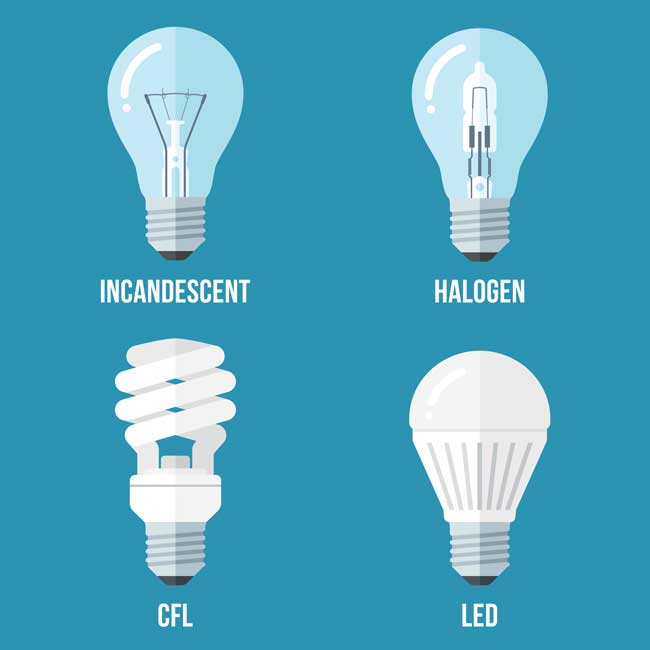Once I moved into my house, it didn’t take me very long to want a brighter garage. I bet you feel the same way.
But how can you tell how many lights you need to make your garage as bright as you want? And what kind of lights do you need?
It all comes down to just how many lumens for garage lighting you need.
LED lights are rated in terms of Lumens. The number of lumens emitted by your lights determines the general brightness of the lighting in the garage.
The Illuminating Engineering Society (IES) guidelines recommend a minimum of 50 lumens per square foot of space. The average one-car garage needs a minimum of 12,800 lumens, while a two-car garage requires a minimum of 20,800 lumens.
| Garage Size | Average Size | Lumens Required |
| 1 Car Garage | 256 sq. ft. | 12,800 Lm |
| 1.5 Car Garage | 364 sq. ft. | 18,200 Lm |
| 2 Car Garage | 416 sq. ft. | 20,800 Lm |
| 2.5 Car Garage | 452 sq. ft. | 22,600 Lm |
| 3 Car Garage | 588 sq. ft. | 29,400 Lm |
| 4 Car Garage | 760 sq. ft. | 38,000 Lm |
| 5 Car Garage | 920 sq. ft. | 46,000 Lm |
| 6 Car Garage | 1,176 sq. ft. | 58,800 Lm |
So, how do you figure out how many lumens you need to light a garage properly?
First, let’s talk about a lumen and how it compares to watts.

Table of Contents
Lumens vs. Watts
We’re used to seeing light bulbs in terms of watts. 60W, 100W, etc., but watts measure the energy a light bulb uses, not how much light it gives off.
Usually, higher wattage means a brighter bulb, but not always.
CFL light bulbs, the twisty fluorescent light bulbs, produce a comparable level of light at a fraction of the energy consumption of our old incandescent bulbs. However, the manufacturers listed them in terms of watts of power used, confusing consumers.
These days, LED lights are rated in Lumens.
But what is a lumen?
Lumens are the raw quantity of light an object produces, not the amount of power that the light bulb uses.
How many lumens you need for your garage depends on what you’re planning on doing in your garage, so there’s no “one light fits all” solution.
Thankfully, there’s a simple calculation we can do to figure it out for your specific garage.
Don’t worry. I’ll keep the math to a minimum. :)
How to Calculate Lumens for Garage Lighting
Now, let’s talk about how we get to the numbers I listed at the beginning of this article.
1. Recommended Lumens Per Square Foot
The Illuminating Engineering Society (IES) recommended guidelines for lighting based on how the space is used. They’re written for commercial buildings, but they offer some valuable insights, which we’ll use here. (pdf source)
They recommend 50 lumens per square foot for an automotive showroom or service area.
We will assume your garage needs at least the same amount of light.
2. Measure Your Garage
The other input we need is the square footage of your garage. We’ll use this to determine how much lighting you need in your garage.
Imagine a standard one-car garage is 12′ x 22′, which gives it 264 sq. ft. of space.
Similarly, if your two-car garage is around 20′ x 20′, although there’s slightly more variability in size. That equates to approximately 400 sq. ft. of space.
3. Multiply Together
Now that you have those two numbers, we multiply them to get the total number of lumens you need for your garage.
One Car Garage
50 lumens/Sq. Ft. x 264 Sq. Ft = 13,200 lumens
Two Car Garage
50 lumens/Sq. Ft. x 400 Sq. Ft = 20,000 lumens
A one-car garage needs a minimum of 13,200 lumens, and a two-car garage requires a minimum of 20,000 lumens.
Remember, this is the minimum. The number of lumens you need may increase based on how you use your garage.
In my case, I wanted my garage lighting to be as bright as possible, so I went with a minimum of 100 lumens per square foot. This was around 48,000 lumens for my two-car garage.
For more on my garage lighting installation, click to read this article.

How Many Lumens for Garage Workbenches?
People who use their garage as their main workshop or car detailing need brighter lighting (higher lumens) than those who only park their vehicle.
The Illuminating Engineering Society (IES) recommends having 300 lumens per square foot in a workshop area.
To calculate how many lumens you need, you need to figure out the area of your workshop area.
Lumen calculation example:
If your workshop table is 6 feet by 2.5 feet, the square footage of your table is 6 x 2.5 or 15 square feet.
Since you should install 300 lumens per square foot for workshop areas, this comes out to 4,500 lumens to adequately light your workshop table area.
That sounds like a lot. In reality, it’s about what you get from one four-foot LED light fixture.
Keep in mind that these are only general guidelines.
Garages with dark walls or shaded light fixtures will need to increase the number of lumens to compensate. By contrast, garages with windows will have enough ambient lighting, so you won’t need as many light fixtures.
Types of lights: Incandescent vs. Fluorescent Lighting vs. LED
How much lighting you need for your garage doesn’t depend on what you plan to do in the garage.
It also depends on what kind of lighting you install.

There are several different kinds of lights available:
- Incandescent lighting: These are your “old school” light bulbs. Incandescent bulbs comprise a tungsten filament encased in a glass housing. They are one of the oldest forms of electric lighting. They are currently being phased out and replaced with LED and CFL lighting.
- Fluorescent lighting: Fluorescent lighting is a low-pressure mercury-vapor gas-discharge lamp that uses fluorescence to produce visible light. Fluorescent lights need to warm up before reaching full brightness. This usually takes several seconds to several minutes.
- CFL (compact fluorescent lamp) lighting: CFL lighting is a type of fluorescent lighting specifically designed to replace incandescent lighting and is often engineered to fit into the same fixtures that previously powered incandescent lights.
- LED (light-emitting diode) lighting: Light-emitting diodes (LED bulbs) are semiconducting light sources that emit light when current flows through them. They’re incredibly efficient and have an extremely long lifespan.
Even though they’re more expensive initially, most people switch out their fluorescent and CFL lighting in favor of LED lights.
Color temperature is also important in your garage. It is generally recommended that cool-colored fluorescent, CFL and LED lighting be used in auxiliary workspaces such as garages and shops.
Advantages of LED and CFL lights:
More Efficient
LEDs and fluorescent lighting put out a much higher number of lumens per watt than incandescent lighting, making them more efficient.
For example, a 60-watt light bulb emits 800 lumens, while a similar brightness LED light only uses between 6-8 watts!
Less Heat
Fluorescent and LED lights emit very little heat as a by-product of their light generation. They are less likely to cause a burn injury or inadvertently start a fire.
It also means you won’t need to look for ways to keep your garage cool, which is a big deal here in Florida.
Besides their fire and heat safety advantages, LEDs and fluorescent lights release less heat and are more efficient. Using these lights in your garage will mean you’ll spend less on air conditioning.
Different Kinds of Garage Lighting
Now that we’ve covered the different types of lights, I highly recommend LED lights.
LED lights are more efficient and last longer than their incandescent bulbs. They’re not as cheap as fluorescent lights, but they don’t take as long to warm up to their full brightness.
Now, let’s figure out what lighting fixtures are best for installing in a garage.
Earlier, we calculated how many lumens you need to adequately light your garage. We divide that number by the number of lumens each fixture puts out.
See? I told you I’d keep the math simple.
Here are the lighting fixtures I recommend, depending on your needs:
- Tube lighting: Tube lighting is usually best if you’re going with LED lighting. This lighting goes by T5, T8, or T12 designations. Choose the T5 or T8 type bulbs, which are more energy-efficient than the T12 models.
- Shop lights: Typically, shop lights will be fluorescent, but they’re also available in LED. Shop lights are a good choice for many small garages. They are inexpensive and usually come with plugs, so no wiring is required for installation.
- Motion-activated lights: Motion-activated lights can be an excellent choice to improve light efficacy in your garage. While they can be more expensive than some light fixture options, they pay for themselves in cumulative saved energy costs.
How to Tell How Many Lumens Your Light Emits
If you’re replacing a light, you usually want something as bright or brighter. However, it may be tough to remember how many lumens your current bulb puts out.
Thankfully, there’s an easy way to tell.
A Federal Trade Commission (FTC) Lighting Label is found on lighting fixtures and bulb packaging.
It breaks down the light’s brightness in lumens along with these other important aspects of a lighting source:
- Approximate annual energy cost
- Bulb life expectancy (in years)
- Color temperature (whether it is a cool or warm colored light)
- Wattage
- Whether or not the bulb contains mercury
Wrapping It Up: Why Lumens Matter
We all want a brightly lit garage so it’s easier to work in.
Out of all the areas in a house, the garage is one space where it is critical to have great lighting, but in most homes, it’s one of the darkest rooms in the entire house.
Dim garages can lead to difficulties in finding equipment and tools. The strain on your eyes can lead to more severe consequences, such as falls or other injuries. You should never have to use a flashlight or penlight in your garage to find something you need.
Hopefully, this helps you figure out how many lumens you need to work in a brightly lit garage.
Once you calculate how many lumens you need for your garage, the next step is to find the best LED shop lights. Check out my super-detailed guide to garage lighting for more tips!
And if you’re wondering which high-lumen LED lights I hardwired in my garage, here they are!
Barrina T8 4' LED Shop Lights |
Hykolity 8' LED Shop Light |
Barrina 4' LED Shop Light |
|
4.4
|
4.8
|
4.0
|



